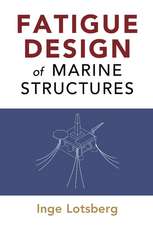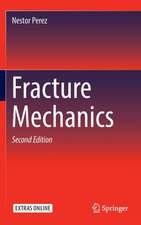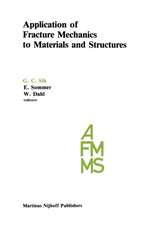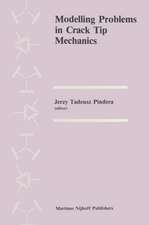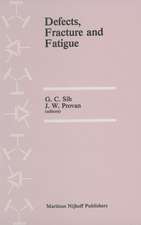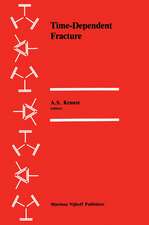Proceedings of an international conference on Fracture Mechanics in Engineering Application: Held at the National Aeronautical Laboratory Bangalore, India March 26-30, 1979
Editat de George C. Sih, S.R. Vallurien Limba Engleză Paperback – 16 feb 2012
| Toate formatele și edițiile | Preț | Express |
|---|---|---|
| Paperback (1) | 1244.89 lei 6-8 săpt. | |
| SPRINGER NETHERLANDS – 16 feb 2012 | 1244.89 lei 6-8 săpt. | |
| Hardback (1) | 1251.37 lei 6-8 săpt. | |
| SPRINGER NETHERLANDS – 31 dec 1979 | 1251.37 lei 6-8 săpt. |
Preț: 1244.89 lei
Preț vechi: 1518.16 lei
-18% Nou
Puncte Express: 1867
Preț estimativ în valută:
238.22€ • 254.73$ • 198.61£
238.22€ • 254.73$ • 198.61£
Carte tipărită la comandă
Livrare economică 18 aprilie-02 mai
Preluare comenzi: 021 569.72.76
Specificații
ISBN-13: 9789400995765
ISBN-10: 9400995768
Pagini: 892
Ilustrații: 890 p.
Dimensiuni: 155 x 235 x 47 mm
Greutate: 1.23 kg
Ediția:Softcover reprint of the original 1st ed. 1979
Editura: SPRINGER NETHERLANDS
Colecția Springer
Locul publicării:Dordrecht, Netherlands
ISBN-10: 9400995768
Pagini: 892
Ilustrații: 890 p.
Dimensiuni: 155 x 235 x 47 mm
Greutate: 1.23 kg
Ediția:Softcover reprint of the original 1st ed. 1979
Editura: SPRINGER NETHERLANDS
Colecția Springer
Locul publicării:Dordrecht, Netherlands
Public țintă
ResearchCuprins
Section I Ductile Fracture.- Mechanics of crack growth: Geometrical size effect in fracture.- Ductile fracture of aluminum tensile specimens.- Plane stress slip-line fields for crack-tip plastic zones in thin-sheet materials.- Strip yielding model and fracture toughnesses of thin and tough plates.- Near tip fields in a cracked plate according to deformation theory.- Analytical and finite element considerations of certain linear and nonlinear aspects of fracture mechanics.- Effects of stress triaxiality on ductile fracture initiation and ductile-brittle transition in prestrained steel.- Comparison of theoretical and experimental results pertaining to R-curves in low and high ductility solids.- Section II Fracture of Metal Alloys.- Elevated temperature strength and fracture toughness determinations of sintered alpha silicon carbide.- Fracture toughness measurements by microfractographic method of common constructional steels.- Influence of microstructure on fatigue crack propagation in aluminium - zinc - magnesium alloys.- Fracture toughness of spheroidal graphite cast iron.- A metallurgical study of electron beam welding of sintered iron.- Improvement in fracture toughness of AISI 4340 steel through electroslag refining.- Section III Fatigue.- On the influence of cyclic loading on the metallurgical stability of type 304 stainless steel at elevated temperatures.- A method for constant amplitude fatigue crack propagation data correlation.- A simple generalised model for fatigue crack propagation.- Engineering application of fracture mechanics to flight simulation fatigue crack propagation.- Initiation and growth of fatigue crack in cylindrical specimens of carbon steels under rotary bending loads.- Residual deformations in the vicinity of a fatigue crack tip.- An analytical derivation of fatigue damage criterion for ASCR stranded conductors.- A new method of arresting fatigue crack growth by artificial wedge.- Section IV Composite and Fatigue.- An engineering approach to static and fatigue behavior of flawed fiber-composite laminates.- Fatigue behaviour prediction for carbon fibre reinforced plastics.- Control of crack propagation in metals by the use of composites.- Crack growth behavior at the boundary of composed materials.- Section V Composite Materials.- Aramid Fiber Composites.- Punching shear and penetration characteristics of some fiber reinforced composites.- Fracture resistance of random fiber glass composites.- Mixed mode fracture in orthotropic media.- Problems of fatigue in composite members.- On the behaviour of cracks in laminated composite panels.- Effect of surface and adhesive preparation on the fracture mode of aluminium-epoxy bonded specimens.- Section VI Engineering Fracture Problems.- Geothermal energy: Thermomechanics of heat extraction from hot, dry rock masses.- Fracture mechanics of brick masonry.- Forced vibration of a fluid-filled hydraulic fracture.- Fracture behaviour of a high tension bolt material.- Failure analysis of engineering components.- Fracture behaviour of high-speed grinding wheels.- On the interaction of geological fractures and mining induced fractures.- Section VII Experimental and Testing Methods.- Reactor Vessel nozzle cracks; a photoelastic study.- Fracture strength of pre-cracked charpy beams.- A secant compliance method for calculating plane strain fracture toughness in medium strength steel.- Fractographic features in 12 cr steels.- Application of Kikukawa’s compliance method to part-through crack growth at the root of a notch.- Section VIII Analytical Modeling.- Energy balanceconsiderations during stable crack growth.- The brittle fracture of cutting tools.- On a new cumulative damage model for fatigue.- Initiation and quasi-static extension of fracture in viscoelastic media (experiment versus theory).- Plastic energy dissipation rate during stable crack growth in a plate of finite thickness under biaxial loading.- Section IX Numerical Analysis.- The fictitious crack model and its use in numerical analyses.- Analysis of dynamic problems of cracks in anisotropic solids by a finite difference method (The AWMP code).- A mixed finite element for accurate crack tip stress analysis.- Determination of stress intensity factors using mixed elements.- Section X Stress Analysis.- Apex singularities for corner cracks under opening, sliding, and tearing modes.- On a model of thermal cracks.- Effect of cracks in solids.- Stress intensity factors of an infinite row of pair of Griffith cracks whose faces are loaded asymmetrically.- On the bending stress distribution at the tip of a stationary crack from Reissner’s theory.- Thermal stress in dissimilar media with a crack.- Section XI Structure Applications.- Characterization of fracture toughness at crack extension by developed deformation; in particular, for linepipe steels, comparison with energy balance considerations.- The application of fracture mechanics to welded structures.- Propagation of edge cracks in laterally excited stiffened panels.- Fracture mechanics in relation to failure in masonry dams.- Application of fracture mechanics to crack growth damage in pavements.- List of Participants.



